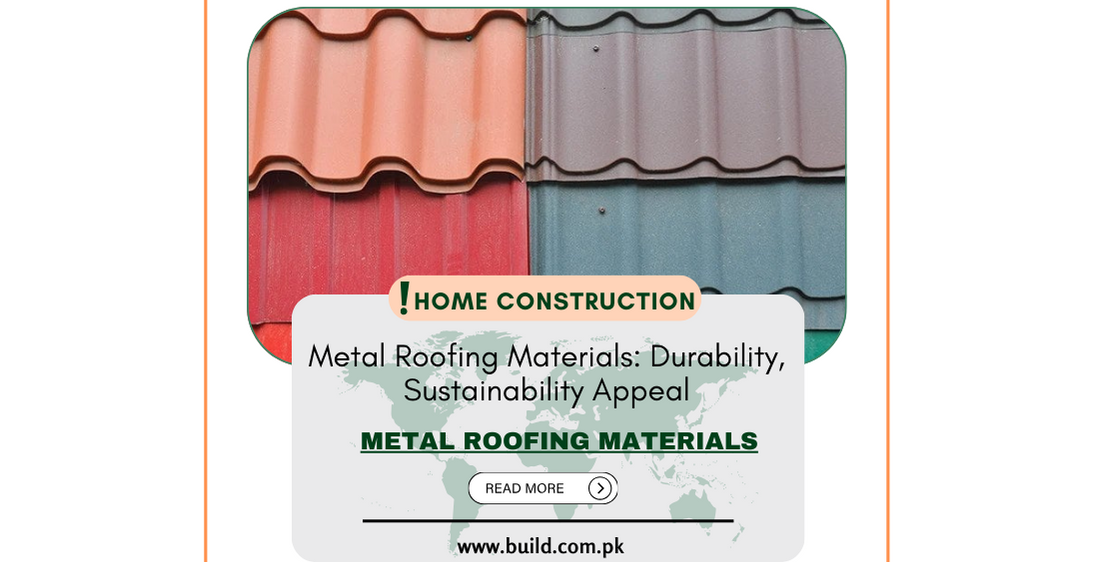Metal Roofing Materials: Durability, Sustainability Appeal

Introduction:
Metal
roofing stands as a durable, eco-friendly, and versatile option for residential
and commercial buildings. This comprehensive guide explores the types,
advantages, environmental impact, installation methods, maintenance, and market
availability of metal roofing materials.
Understanding Metal Roofing Materials
Durability and Longevity:
Metal
roofing materials are known for their exceptional durability and longevity.
They can withstand harsh weather conditions, including heavy rain, snow, hail,
and high winds, offering a lifespan of 40-70 years, far surpassing traditional
roofing materials.
Energy Efficiency:
Metal roofs
reflect solar radiant heat, keeping interiors cooler and reducing cooling
costs, especially in warmer climates. They can also be coated with reflective
pigments to further enhance their energy-saving prop erties.
Environmental Benefits:
Metal
roofing materials are highly recyclable and contribute to sustainable building
practices. They often contain recycled content and can be fully recycled at the
end of their life span, reducing the demand for new raw materials.

Types of Metal Roofing Materials
Steel Roofing:
Steel
roofing is one of the most common and economical options. It's available in
various gauges and coatings, such as galvanized or Galvalume® steel, offering
resistance against corrosion and enhancing durability.
Aluminum Roofing:
Aluminum
roofing excels in corrosion resistance, making it an ideal choice for coastal
regions or areas prone to high humidity. Lightweight and recyclable, it's an
environmentally friendly option.
Copper Roofing:
Copper
roofing, known for its longevity and distinctive appearance, develops a patina
over time, offering natural protection against corrosion. Its aesthetic appeal
and durability make it a premium choice.
Zinc Roofing:
Zinc roofing
is renowned for its durability and self-healing properties due to patina
formation. It's low maintenance and provides excellent resistance against
corrosion and weathering.
Advantages of Metal Roofing
Longevity and Durability:
Metal roofs
can last 40-70 years, outperforming traditional asphalt roofs. They withstand
harsh weather conditions, including high winds, hail, and fire, ensuring
long-term protection.
Energy Efficiency:
Metal roofs
reflect solar radiant heat, reducing cooling costs in warmer climates. They can
also be coated with reflective pigments, further enhancing energy efficiency.
Eco-Friendliness:
Metal
roofing is highly recyclable, reducing landfill waste. Some options contain
recycled materials, and they're fully recyclable at the end of their life span.
Drawbacks of Metal Roofing Materials
Initial Cost:
One of the
primary drawbacks of metal roofing is its higher initial cost compared to
traditional roofing materials like asphalt shingles. The upfront investment
might deter some homeowners, although the long-term benefits often outweigh
this initial expense.
Denting and Noise:
In regions
prone to hail or falling debris, some metal roofs may dent. Additionally,
during heavy rainfall or hailstorms, the sound of rain hitting the metal
surface can be perceived as noisy by some individuals, although proper
insulation can minimize this effect.
Expansion and Contraction:
Metal
roofing materials can expand and contract with temperature fluctuations.
Improper installation without allowing for this movement may cause issues such
as warping or loosening of fasteners over time.
Scratching and Fading:
Certain
metal finishes, pa:rticularly painted surfaces, might be prone to scratching or
fading over time due to exposure to the elements. Regular maintenance and
choosing high-quality coatings can mitigate these issues.
Installation Complexity;
Metal roofs require
profes:sional installation. Improper installation techniques or inexperienced
contractors might lead to water leakage, improper sealing, or reduced longevity
of the roofing system.
Environmental Impact and Sustainability
Recyclability:
Metal roofing
materials are highly recyclable, contributing to susta inable building
practices. Recycled content in metal roofs can range from 25% to 95%, reducing
the demand for new raw materials.
Energy Savings:
The
energy-efficient properties of metal roofs reduce reliance on HVAC systems,
leading to lower energy consumption and carbon emissions.
Installation, Maintenance, and Market Availability
Installation Methods:
Metal
roofing requires professional installation. It can be installed as standing
seam panels, shingles, or sheets, depending on the chosen material and design.
Maintenance Requirements
Metal roofs
generally require minimal maintenance, with occasional inspections for damaged
panels or coatings. Cleaning with mild solutions ensures longevity.
Market Availability:
Renowned
manufacturers like CertainTeed, Owens Corning, and Englert offer a variety of
metal roofing materials. Local roofing suppliers and contractors also provide a
range of options and installation services.
Conclusion:
Metal
roofing materials embody durability, sustainability, energy efficiency, and
aesthetic appeal, making them a popular choice for residential and commercial
buildings. Their long lifespan, low maintenance require ments, and eco-friendly
properties contribute to their increasing market demand.
Whether
seeking steel, aluminum, copper, or zinc roofing, the diverse options available
cater to various preferences, providing lasting protection and aesthetic
enhancement for structures.
This
comprehensive guide covers the types, advantages, environmental impact,
installation, maintenance, and market availability of metal roofing materials,
highlighting their significance in the construction industry as durable,
sustainable, and aesthetically appealing options for roofing solutions.









